Charging Electric Vehicles with Renewable Energy: Science & Innovation
Category: Renewable Energy
Unlocking the Power of Renewables for EV Charging
Whether you're a curious beginner eager to understand the mechanics of charging electric vehicles (EVs) with green energy or an electrical engineer seeking an in-depth examination of the latest innovations, this post is crafted for you. Finding reliable and efficient ways to power EVs sustainably is a pivotal challenge as the world shifts towards decarbonization. Perhaps you've landed here wondering: How exactly can solar and wind energy, alongside other emerging renewables, be reliably integrated for EV charging? What are the technological hurdles and advancements that shape this integration? This post differentiates itself by blending accessible explanations with technical depth, guiding you through core concepts, system design considerations, innovations, and real-world applications. You'll gain clarity on energy sources, storage solutions, grid interactions, and future prospects. With the explosion of EV adoption, understanding this synergy ensures you’re not just charging a vehicle, but driving toward a sustainable energy future. Dive in to explore the science and innovation turning renewable energy into the fuel for mobility.
- Unlocking the Power of Renewables for EV Charging
- Overview of Renewable Energy Sources for EV Charging
- Technical Foundations of EV Charging
- Solar-Powered EV Charging Systems
- Wind Energy for EV Charging
- Energy Storage and Management for Renewable EV Charging
- Grid Interaction and Smart Charging
- Emerging Technologies and Innovations in Renewable EV Charging
- Challenges and Solutions for Scaling Renewable EV Charging
- Case Studies and Real-World Implementations of Renewable EV Charging Stations
- Future Trends and Research Directions in Renewable EV Charging
Overview of Renewable Energy Sources for EV Charging
When it comes to sustainably powering electric vehicles, solar, wind, and emerging renewable technologies stand as the primary pillars of clean energy integration. Each source offers unique advantages and challenges that influence their suitability for various EV charging scenarios, from residential use to large-scale public charging stations.
Solar Energy: The Most Accessible Renewable Solution
Solar photovoltaic (PV) systems are the most widely adopted renewable energy solution for EV charging due to their scalability, declining costs, and ease of installation. Solar panels can be integrated on rooftops, parking lots, or even directly into charging stations, providing a clean, decentralized power source. They are particularly well-suited for:
- Home charging — enabling EV owners to directly offset electricity consumption with solar generation.
- Public and workplace charging — offering daytime renewable energy when vehicle demand often peaks.
- Off-grid installations — combined with battery storage, solar enables EV charging in remote areas lacking grid infrastructure.
Solar’s predictability during daylight hours and continual technological improvements in panel efficiency contribute to its dominance in the EV charging landscape.
Wind Energy: High Capacity, Location-Specific Power
Wind turbines provide a powerful, albeit more location-dependent, source of renewable electricity. Wind energy excels in regions with steady, strong wind resources and can supply high-capacity charging infrastructure such as fast chargers for highway corridors. Key considerations for wind-powered EV charging include:
- Intermittency and variability, requiring integration with energy storage or grid balancing.
- Suitability for utility-scale renewable farms feeding directly into the electricity grid powering public charging networks.
- Potential for hybrid systems combining solar and wind to maximize availability.
While less common for individual EV owners due to installation complexity and space requirements, wind energy plays a critical role in decarbonizing the electrical grid that ultimately supports widespread EV adoption.
Emerging Renewable Technologies: Innovative Pathways
Beyond solar and wind, pioneering renewable technologies such as:
- Floating solar arrays,
- Tidal and wave energy converters, and
- Advanced bioenergy systems
are beginning to influence EV charging solutions, especially where traditional options are limited. These innovations offer promising avenues for expanding renewable electricity generation in diverse environments and can be paired with advanced smart grid management and energy storage technologies to optimize EV charging efficiency and reliability.
By understanding the characteristics and suitability of these core renewable energy options, stakeholders can strategically implement EV charging infrastructure that maximizes clean energy use, reduces grid strain, and accelerates the transition to sustainable mobility.
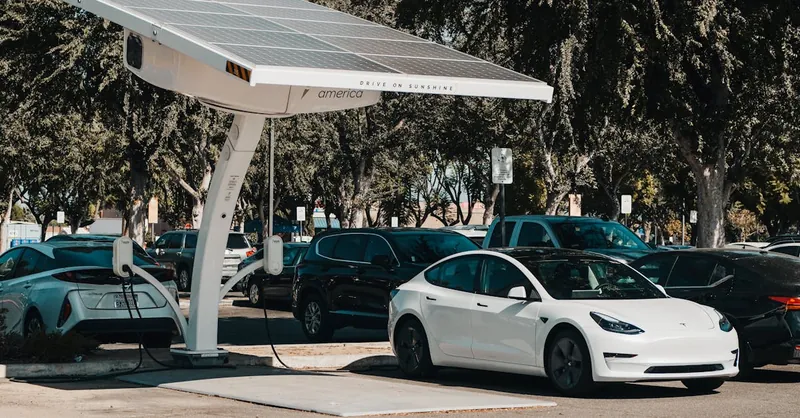
Image courtesy of Kindel Media
Technical Foundations of EV Charging
Understanding the technical aspects of electric vehicle charging is crucial for integrating renewable energy sources effectively. EV chargers are categorized primarily into Level 1, Level 2, and DC fast charging, each differing in power delivery, charging speed, and infrastructure requirements. These distinctions directly influence how renewable energy systems can be optimized to meet EV demand.
Types of EV Chargers and Power Requirements
- Level 1 Charging
- Uses a standard household outlet (120V AC in North America).
- Delivers up to 1.4 kW of power, providing approximately 3 to 5 miles of range per hour of charging.
- Suitable for overnight residential charging where slower rates are acceptable.
-
Minimal infrastructure required, making it easier to pair with small-scale solar PV systems.
-
Level 2 Charging
- Operates at higher voltages (typically 208-240V AC) supplying 3.3 to 19.2 kW power.
- Enables faster charging—about 10 to 60 miles of range per hour.
- Frequently deployed in homes, workplaces, and public stations, benefitting from dedicated electric circuits.
-
Optimally paired with on-site renewables and energy storage to manage demand peaks and align with renewable generation profiles.
-
DC Fast Charging (DCFC)
- Delivers direct current at very high power levels, ranging from 50 kW to over 350 kW.
- Enables rapid charging, replenishing 60 to 80 miles of range in 20 minutes or less.
- Requires substantial power infrastructure and coordination with grid operators.
- Integration with large-scale wind farms or utility-scale solar plants and battery storage systems is essential to manage grid stability and renewable intermittency.
Charging Protocols and Renewable Energy Integration
Effective EV charging relies on standardized communication protocols that manage energy flow, optimize charging speed, and enable smart charging features crucial to renewable integration:
- IEC 61851 and SAE J1772 define electric vehicle conductive charging systems mainly for AC Level 1 and Level 2 chargers.
- CHAdeMO, CCS (Combined Charging System), and Tesla Supercharger protocols govern DC fast charging infrastructure, with varying compatibility and power delivery capabilities.
These protocols facilitate important functionalities such as:
- Demand response and load shifting, aligning EV charging timing with periods of abundant renewable generation (e.g., midday solar peaks or nighttime wind surges).
- Vehicle-to-Grid (V2G) communication, allowing EVs to act as distributed energy storage that can discharge electricity back to the grid when renewable output dips.
- Smart charging algorithms that integrate real-time data from renewable energy forecasts, grid status, and pricing signals to maximize green energy utilization.
By mastering the unique power requirements of each charging level and leveraging advanced protocols, renewable energy can be seamlessly matched with EV charging needs. This synergy not only enhances system efficiency but also reduces reliance on fossil-fuel-based grid power, accelerating the adoption of sustainable transportation and cleaner grids.
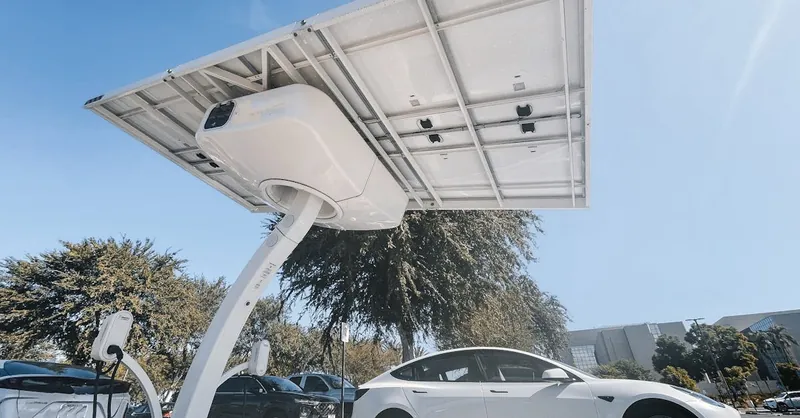
Image courtesy of Kindel Media
Solar-Powered EV Charging Systems
Harnessing solar energy to charge electric vehicles combines the advantages of clean, renewable power with the convenience and accessibility of sunlight. Photovoltaic (PV) system designs for EV charging primarily revolve around on-site generation to minimize transmission losses and maximize efficiency. These systems are typically implemented as either rooftop-mounted or ground-mounted solar arrays, each suited to different site conditions and space availability.
Photovoltaic Array Configurations
- Rooftop Solar Arrays
- Ideal for residential and commercial buildings with ample roof space and favorable solar exposure.
- Utilize existing structures, reducing land use and installation costs.
- Well-matched with home Level 1 or Level 2 EV chargers for direct consumption of daytime solar power.
-
Often paired with energy storage systems (batteries) to extend renewable usage into evening charging periods.
-
Ground-Mounted Solar Arrays
- Suitable for larger scale installations such as workplace charging hubs or public EV stations with sufficient land availability.
- Can be optimized for sun-tracking to increase energy yield and maximize power output.
- Flexibility in orientation and spacing enables better system sizing and scalability.
- Often integrated with fast charging infrastructure requiring higher power delivery and robust system design.
Inverter Technologies and Power Conversion
The efficiency and reliability of solar-powered EV charging heavily depend on advanced inverter technologies that convert the DC electricity generated by PV panels into AC power compatible with EV chargers and the electrical grid. Key inverter considerations include:
- Grid-tied inverters synchronize solar output with the local utility grid, allowing for export of excess energy and compliance with grid codes.
- Hybrid inverters incorporate built-in battery management and support off-grid or backup power modes, crucial for ensuring charging availability during grid outages or low solar periods.
- String inverters vs. microinverters: String inverters manage multiple panels in series, offering cost efficiency, while microinverters optimize individual panel performance, mitigating shading and mismatch losses.
Effective inverter selection enhances system resilience and supports dynamic power flows between solar arrays, onsite EV chargers, battery storage, and the grid.
Integration with EV Chargers and Smart Energy Management
Seamless integration between PV systems and EV chargers is essential for maximizing renewable energy utilization and providing a smooth user experience. This integration often involves:
- Dedicated solar EV charger controllers that modulate charging rates based on real-time solar generation and battery state-of-charge.
- Use of smart meters and energy management systems (EMS) to monitor energy flows, automate load shifting, and prioritize solar consumption over grid electricity.
- Incorporation of vehicle-to-home (V2H) or vehicle-to-grid (V2G) capabilities, enabling bidirectional energy exchange, further enhancing grid stability and renewable energy dispatch.
- Advanced data analytics and IoT connectivity to predict solar availability and optimize charging schedules accordingly.
By combining tailored PV system designs, cutting-edge inverter solutions, and intelligent charging integration, solar-powered EV charging systems deliver a highly efficient, flexible, and environmentally friendly solution that empowers EV owners and operators to drive on clean energy—fueling the transition to a sustainable transportation future.
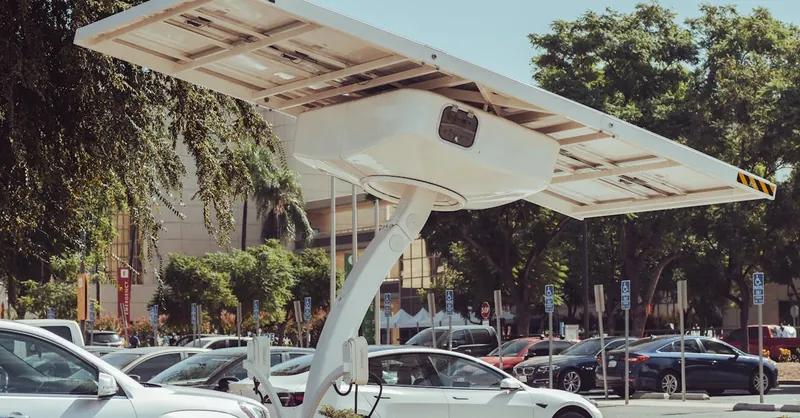
Image courtesy of Kindel Media
Wind Energy for EV Charging
Harnessing wind power to charge electric vehicles offers a compelling pathway to sustainable mobility, especially in regions with abundant wind resources. Wind turbines convert the kinetic energy of moving air into electrical power through well-established electromechanical principles. This renewable energy source is highly effective for large-scale and utility-driven EV charging infrastructures, providing high-capacity and low-carbon electricity that supports fast and widespread vehicle charging.
Turbine Types Suitable for EV Charging Projects
When integrating wind energy into EV charging systems, the choice of turbine significantly impacts performance and feasibility. Common turbine types include:
- Horizontal Axis Wind Turbines (HAWTs)
- The most prevalent type, featuring blades that rotate around a horizontal shaft.
- Capable of generating large amounts of power (from kilowatts to several megawatts).
-
Suited for utility-scale wind farms feeding power directly into the grid that supports public charging networks.
-
Vertical Axis Wind Turbines (VAWTs)
- Have blades rotating around a vertical axis, enabling omni-directional wind capture.
- Typically smaller and more compact, making them suitable for distributed generation, such as on-site EV charging installations where space and variable wind directions are factors.
-
Lower maintenance requirements and quieter operation, which is an advantage in urban or suburban environments.
-
Small and Micro Wind Turbines
- Designed for residential or small commercial EV charging setups.
- While these turbines produce less power, they can be combined with solar PV and battery systems to create hybrid renewable charging solutions.
Impact of Wind Variability on Charging Reliability
A core challenge of wind-powered EV charging lies in the inherent intermittency and variability of wind resources. Wind speed fluctuations directly affect turbine output, which creates challenges for maintaining consistent charging availability. Key considerations include:
- Energy Storage Integration: Combining wind turbines with battery storage systems buffers variability, storing excess generation during high wind periods to supply power when wind slows.
- Grid Connection: Wind farms typically feed electricity into the broader grid, where grid operators balance supply and demand, ensuring EV charging reliability even during wind lulls.
- Hybrid Systems: Pairing wind energy with other renewables (like solar) increases overall system resilience, as solar generates during daylight and wind may peak at different times, smoothing the combined output.
- Predictive Analytics: Advanced weather forecasting and real-time monitoring enable fine-tuning of EV charging schedules to align demand with anticipated wind availability, optimizing renewable energy utilization.
By understanding turbine types and managing wind variability through intelligent storage and grid coordination, wind energy can become a cornerstone of scalable, clean EV charging infrastructure—powering the electrification of transport while reducing dependence on fossil fuels.

Image courtesy of Andersen EV
Energy Storage and Management for Renewable EV Charging
A critical challenge in powering electric vehicles (EVs) with renewable energy lies in managing the intermittency and variability of solar, wind, and emerging resources. This is where advanced Battery Energy Storage Systems (BESS), smart grid configurations, and energy management strategies play a pivotal role in ensuring reliable, optimized EV charging around the clock.
Battery Energy Storage Systems (BESS)
BESS are indispensable for buffering fluctuations in renewable generation and aligning energy supply with EV charging demand. By storing excess renewable power generated during peak solar or wind periods, batteries enable sustained charging during cloudy days, calm wind conditions, or nighttime.
Key benefits of BESS in EV charging include:
- Load Shifting and Peak Shaving
Batteries store surplus energy when renewables exceed immediate demand and discharge during high-demand intervals, reducing grid stress and avoiding fossil-fueled peaker plants. - Frequency Regulation and Grid Stability
Fast-responding battery storage helps maintain grid frequency and voltage, crucial when large volumes of variable renewables are integrated with EV chargers. - Enhanced Renewable Energy Utilization
BESS maximizes onsite renewable consumption by smoothing output variations, lowering the need for grid electricity sourced from non-renewable generation. - Support for Off-Grid and Microgrid Applications
In off-grid EV charging setups, combined battery and renewable systems provide energy autonomy, enabling EV use in remote locations without grid access.
Grid-Tied vs. Off-Grid Configurations
Understanding the deployment context for renewable-powered EV charging systems influences the design of storage and management solutions:
- Grid-Tied Systems
These setups connect renewable generation and BESS to the utility grid, leveraging grid power as backup and export capabilities. Grid-tied configurations benefit from: - Dynamic energy balancing using grid services
- Possibility to participate in demand response programs and time-of-use pricing
-
Enhanced overall system resilience and scalability
-
Off-Grid Systems
Typically employed in remote areas or as backup solutions, these systems rely solely on onsite renewables and battery storage for EV charging. Challenges include: - Precise capacity planning to match variable load and generation profiles
- Advanced battery management to prevent outages and extend system longevity
- Often integrating hybrid renewables (solar, wind, bioenergy) to diversify energy inputs
Energy Management Strategies
Effective energy management optimizes charging schedules and storage dispatch to maximize renewable consumption and grid benefits. Important strategies include:
- Smart Charging and Load Scheduling
Utilizing forecast data and real-time monitoring, charging sessions are shifted to periods of high renewable availability, reducing reliance on grid power and lowering charging costs. - Vehicle-to-Grid (V2G) and Vehicle-to-Home (V2H) Integration
These bidirectional energy flows allow EV batteries to serve as distributed storage assets, feeding power back to the grid or home during peak demand or low renewable generation periods. - Demand Response Participation
Coordinating EV charging with grid signals enables flexible demand reduction or augmentation, facilitating grid stability and enhancing renewable integration. - Advanced Energy Management Systems (EMS)
EMS platforms aggregate data from renewable generation, storage, EV loads, and grid status, implementing intelligent control algorithms that balance supply and demand while optimizing system efficiency and battery health.
By incorporating robust battery storage solutions, selecting appropriate grid-tied or off-grid architectures, and employing sophisticated energy management strategies, renewable-powered EV charging systems overcome inherent intermittency challenges. This integration not only assures reliable, green mobility but also strengthens the broader transition towards sustainable energy ecosystems.

Image courtesy of Andersen EV
Grid Interaction and Smart Charging
As renewable energy sources like solar and wind become increasingly prevalent in powering electric vehicle (EV) charging, sophisticated grid interaction and smart charging technologies are essential to enhance efficiency, stability, and renewable utilization. These innovations enable bidirectional energy flows and intelligent demand management, transforming EVs from mere consumers into active participants within the electricity ecosystem.
Vehicle-to-Grid (V2G) Technology
Vehicle-to-Grid (V2G) is a cutting-edge concept where electric vehicles communicate with and supply power back to the grid during periods of peak demand or low renewable generation. This bidirectional flow turns EVs into distributed energy storage units, providing several key benefits:
- Grid Stability and Frequency Regulation
EV batteries can rapidly inject or absorb power, helping balance fluctuations caused by renewable intermittency. - Renewable Energy Maximization
By discharging stored solar or wind energy during non-generation periods, V2G supports better alignment between supply and demand. - Economic Incentives for EV Owners
Participation in V2G programs can allow EV owners to earn revenue or savings by providing grid services.
Realizing V2G requires standardized communication protocols and advanced inverter systems capable of safe, reliable power transfers between vehicles and the grid.
Demand Response and Load Management
Smart charging integrates demand response strategies that dynamically adjust EV charging based on grid conditions, electricity prices, and renewable availability. Key features include:
- Load Shifting: Scheduling charging during periods of high renewable generation (e.g., midday solar peaks or nighttime wind) to reduce grid congestion.
- Peak Demand Reduction: Temporarily pausing or delaying charging during grid stress events to prevent blackouts and reduce reliance on fossil-fueled backup generation.
- User Preferences and Priorities: Customizable settings that balance user convenience with grid-friendly charging schedules.
These demand response mechanisms leverage real-time grid data and predictive analytics to seamlessly coordinate thousands of EV chargers without compromising driver needs.
Smart Grid Technologies Enhancing Renewable EV Charging
Modern smart grid infrastructures employ sensors, IoT connectivity, and AI-powered algorithms to optimize the integration of renewables and EV charging. They enable:
- Real-time Monitoring and Control of generation sources, battery storage, and EV loads, enhancing responsiveness to fluctuations.
- Distributed Energy Resource Management Systems (DERMS) that orchestrate multiple renewable assets alongside EV fleets for optimized energy flows.
- Adaptive Pricing Models that incentivize charging behaviors aligned with renewable availability, accelerating green energy adoption.
These technologies collectively bolster grid resilience, improve the efficiency of renewable EV charging, and facilitate a smoother transition to a carbon-neutral transportation sector.
By harnessing vehicle-to-grid concepts, demand response strategies, and advanced smart grid technologies, the future of EV charging becomes not only cleaner but also more flexible and reliable—effectively turning electric vehicles into mobile assets that support renewable energy integration and grid modernization.
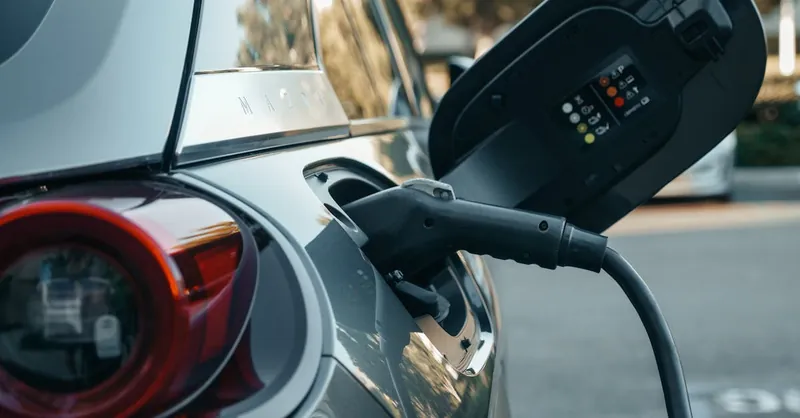
Image courtesy of Kindel Media
Emerging Technologies and Innovations in Renewable EV Charging
As the demand for cleaner and more efficient electric vehicle (EV) charging grows, emerging technologies and innovative solutions are revolutionizing how renewable energy powers the transportation sector. These breakthroughs aim to enhance convenience, optimize renewable energy use, and overcome existing limitations related to intermittency and infrastructure.
Wireless Charging Powered by Renewables
One of the most promising advancements is wireless (or inductive) charging, which enables EVs to charge without physical cables, improving user experience and expanding charging possibilities. When combined with renewable energy sources such as solar or wind, wireless charging systems offer:
- Seamless integration in public spaces and homes, allowing vehicles to charge simply by parking over embedded charging pads.
- Dynamic charging capabilities in smart cities, where wireless coils installed in roadways or parking lots can charge vehicles as they stop or even while in motion.
- Enhanced safety and durability by reducing wear and exposure to environmental elements that affect plug-in connectors.
Coupling wireless EV charging with onsite or nearby renewable energy generation maximizes green energy utilization while facilitating flexible deployment and scalability.
Hybrid Renewable Energy Systems
To tackle renewables' inherent variability, hybrid renewable energy systems combining solar, wind, and sometimes bioenergy or energy storage have gained traction for EV charging applications. These hybrid systems:
- Leverage the complementary generation patterns of different resources—such as solar's daytime peak and wind's often nocturnal strength—to provide more consistent, reliable power.
- Can be optimized through intelligent controllers to dynamically allocate renewable inputs based on availability, cost, and demand profiles.
- Reduce dependence on the conventional grid, enhancing energy autonomy and resilience for EV charging infrastructure, especially in remote or off-grid environments.
Hybrid solutions not only improve the stability and efficiency of renewable-powered EV charging but also reduce overall system costs by maximizing energy yield.
Predictive AI Energy Management Tools
Leveraging artificial intelligence (AI) is transforming energy management for EV charging by enabling predictive analytics and automated optimization tailored to renewable energy patterns and user behavior. AI-powered tools facilitate:
- Forecasting renewable generation and EV charging demand with high accuracy using weather data, historical consumption patterns, and traffic models.
- Dynamic scheduling of charging sessions to prioritize periods of high renewable output and favorable electricity prices, effectively aligning energy supply with demand.
- Real-time monitoring and adaptive control across distributed charging stations, battery storage, and grid resources to optimize overall system performance and grid interaction.
- Preventive maintenance and anomaly detection, improving reliability and reducing operational costs of renewable EV charging infrastructure.
By integrating AI-driven management platforms, operators can significantly boost renewable energy penetration, lower carbon footprints, and enhance the user experience in EV charging ecosystems.
Incorporating these cutting-edge technologies—wireless renewable-powered charging, hybrid energy systems, and predictive AI management—is crucial to advancing the sustainability, scalability, and convenience of electric vehicle charging. As these innovations mature and blend seamlessly with existing renewable assets and smart grids, they will play an essential role in accelerating the global transition to clean, efficient transportation powered by renewable energy.
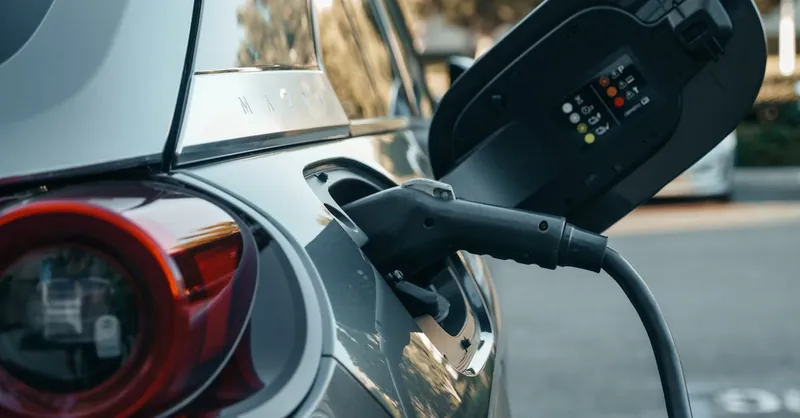
Image courtesy of Kindel Media
Challenges and Solutions for Scaling Renewable EV Charging
Scaling renewable energy-powered electric vehicle (EV) charging infrastructure faces multiple technical, economic, and regulatory challenges that must be addressed to enable widespread adoption and maximize environmental benefits. Key obstacles include:
-
High Infrastructure Costs
Deploying solar arrays, wind turbines, battery storage, and advanced charging stations entails substantial upfront investments. Large-scale projects require capital-intensive grid upgrades and power electronics, which can inhibit expansion, especially in underserved or rural areas. -
Intermittency and Variability of Renewables
Solar and wind power generation fluctuate due to weather and time of day, complicating consistent EV charging availability. This variability demands sophisticated energy management, grid coordination, and storage solutions to maintain reliability. -
Land Use and Siting Constraints
Utility-scale renewable installations and fast charging stations often require significant land area, which can conflict with urban density, environmental preservation, and local zoning regulations. Efficient space utilization and community acceptance are critical considerations. -
Grid Integration and Stability Issues
High penetrations of distributed renewables paired with fast EV chargers stress existing electrical grids. Coordinating supply-demand balance, preventing overloads, and managing bi-directional energy flows challenge grid operators and require advanced smart grid technologies.
Engineering and Technological Solutions
To overcome these challenges, ongoing innovations and strategic engineering approaches include:
-
Hybrid Renewable Systems and Energy Storage
Combining solar, wind, and bioenergy alongside scalable Battery Energy Storage Systems (BESS) enhances generation consistency and EV charging reliability, smoothing output despite fluctuating resource availability. -
Advanced Power Electronics and Inverters
Modern inverters support dynamic grid services, V2G functionality, and seamless integration of multiple energy sources, improving resilience and efficiency. -
Modular, Scalable Charging Infrastructure
Deploying modular DC fast chargers with smart load management enables phased expansion aligned with local renewable capacity and demand profiles, reducing capital barriers.
Policy and Regulatory Frameworks
Robust policy mechanisms are essential to accelerate renewable EV charging adoption:
-
Incentives and Subsidies for renewable EV infrastructure lower cost barriers and encourage private sector investment.
-
Grid Access and Tariff Reforms that support bi-directional flows and time-of-use pricing motivate smart charging aligned with renewable availability.
-
Land Use Planning and Permitting Streamlining expedite deployment of renewable generation and EV charging sites without compromising environmental standards.
-
Standardization and Interoperability policies ensure compatibility of equipment, promoting scalability and user convenience.
Innovative Business Models
Emerging commercial models address financial and operational scaling challenges:
-
Energy-as-a-Service (EaaS) platforms provide turnkey renewable EV charging solutions, bundling generation, storage, and operation under flexible contracts.
-
Aggregator Models leverage smart charging and V2G capabilities to pool EV batteries as grid resources, unlocking new revenue streams.
-
Community Solar and Microgrid Initiatives facilitate localized renewable charging ecosystems that enhance energy autonomy and social acceptance.
By combining engineering advancements, supportive policies, and innovative business strategies, the renewable EV charging sector can effectively tackle cost, intermittency, and land challenges, paving the way for a scalable, resilient, and green transportation future.
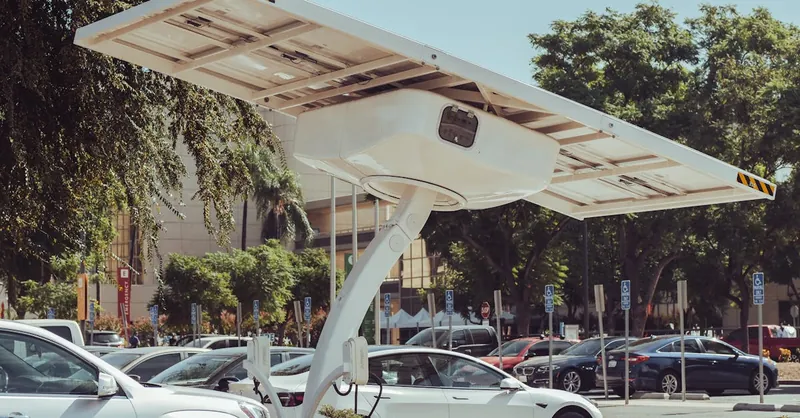
Image courtesy of Kindel Media
Case Studies and Real-World Implementations of Renewable EV Charging Stations
The integration of renewable energy into electric vehicle (EV) charging infrastructure has moved beyond theory into successful real-world applications worldwide. These pioneering projects demonstrate the feasibility, performance benefits, and operational lessons critical to scaling sustainable EV charging solutions. Understanding these case studies provides valuable insights for engineers, planners, and policy makers aiming to replicate or improve renewable EV charging deployment.
Notable Global Examples
-
Tesla’s Solar-Powered Supercharger Stations (United States & Europe)
Tesla has strategically integrated solar canopies and onsite battery storage at several Supercharger sites to reduce grid dependency and increase renewable energy utilization. These stations leverage high-efficiency PV panels combined with advanced energy management systems to moderate charging loads in real-time, ensuring stable fast charging even under variable solar conditions. The approach also highlights the importance of hybrid energy storage to smooth intermittency. -
IONITY Network with Green Energy Sourcing (Europe)
IONITY, a consortium of automotive manufacturers, operates a fast-charging network powered primarily by renewable energy purchased through power purchase agreements (PPAs). Although this model does not always involve on-site generation, it exemplifies how renewable energy sourcing at scale can decarbonize EV charging via contractual mechanisms, complementing physical renewable asset integration. -
Masdar City Electric Vehicle Charging Infrastructure (Abu Dhabi, UAE)
Masdar City showcases a fully integrated urban renewable EV charging ecosystem combining solar PV with wind turbines and extensive battery storage. This microgrid-enabled system manages solar intermittency and peak load demands through smart grid control, demonstrating how hybrid renewable microgrids optimize EV charging within sustainable city planning frameworks. -
The Tesla Gigafactory Renewable Charging Campus (Nevada, USA)
At this large-scale manufacturing and development site, Tesla employs a massive solar installation coupled with battery arrays to power employee EV charging stations onsite. The Gigafactory setting illustrates how corporate renewable energy investments can provide both operational cost savings and sustainability benefits by directly powering EV charging from clean energy sources.
Key Lessons and Performance Insights
- Hybridization is Essential: Combining multiple renewable sources (solar and wind) with battery storage consistently emerges as best practice for improving reliability and matching charging demand profiles.
- Smart Energy Management is Critical: Real-time monitoring, predictive analytics, and dynamic load control significantly enhance renewable energy utilization while maintaining user charging expectations.
- Grid-Connected and Off-Grid Models Coexist: While many projects benefit from grid interconnection to balance supply and demand, off-grid systems with robust storage can enable renewable EV charging in remote or underserved locations.
- Standardization and Interoperability Boost Scalability: Adhering to international charging and communication protocols ensures compatibility and facilitates broader deployment of renewable-enabled charging infrastructure.
- Environmental and Economic Benefits Align: Operational data from these projects show substantial reductions in carbon emissions alongside growing cost-competitiveness as technologies mature and scale increases.
By studying these real-world implementations, stakeholders gain valuable insights into the design, technology integration, and operational strategies that make renewable energy-powered EV charging both practical and impactful across diverse contexts globally.
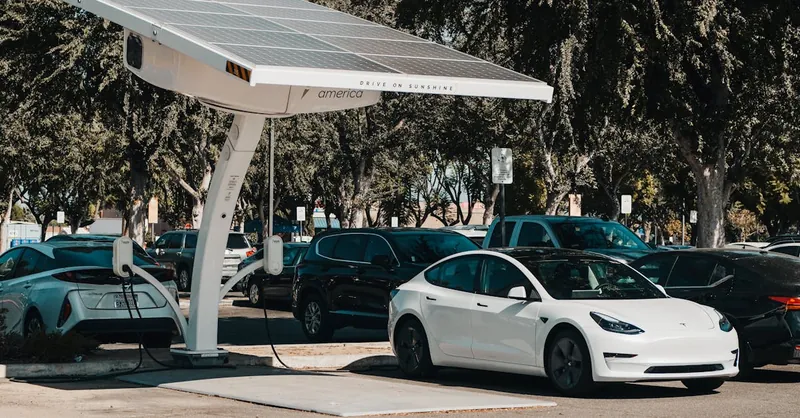
Image courtesy of Kindel Media
Future Trends and Research Directions in Renewable EV Charging
As the electric vehicle (EV) market accelerates globally, future trends and research directions in renewable energy-powered EV charging are focusing on advancing technology integration, enhancing system interoperability, and aligning with ambitious sustainability goals. Key trajectories shaping the evolution of this sector include:
Next-Generation Renewable Technologies and Hybridization
Emerging renewable energy sources such as perovskite solar cells, airborne wind energy systems, and advanced bioenergy conversion technologies promise to augment the capacity and efficiency of clean EV charging infrastructures. Research is intensifying on:
- Hybrid renewable microgrids that seamlessly combine multiple energy sources—solar, wind, tidal, and bioenergy—with intelligent energy storage to optimize charge availability and reduce carbon footprints.
- Energy harvesting innovations, including ambient energy capture (thermal, vibrational), which could supplement primary renewables and extend the temporal availability of green power for EV charging.
- Next-gen battery chemistries and supercapacitors that offer higher energy densities, faster charge-discharge cycles, and improved lifecycle sustainability, enabling more resilient and scalable storage for intermittent renewable outputs.
Standardization Efforts and Interoperability Enhancement
To foster widespread adoption and operational efficiency, international bodies and industry consortia are actively driving standardization in communication protocols, hardware interfaces, and data exchange formats:
- Unified smart charging protocols ensuring compatibility across diverse EV makes, charging hardware, and renewable energy systems support interoperability and simplify user experience.
- Open standards for Vehicle-to-Grid (V2G) and Vehicle-to-Everything (V2X) communications that enable bidirectional energy flows and grid services integration, maximizing both renewable utilization and grid stability.
- Development of cybersecurity frameworks protecting smart charging networks against potential vulnerabilities as EV charging infrastructure becomes increasingly digitized and connected.
Evolving EV Charging Paradigms Aligned with Sustainability
The paradigm of EV charging is shifting from a static, location-bound activity toward a dynamic, smart, and context-aware ecosystem synchronized with renewable generation patterns and user behavior:
- Dynamic pricing and incentive schemes tied to renewable energy availability will encourage consumer load shifting, enhancing grid flexibility and renewable penetration.
- Integration of AI-driven charging management platforms capable of predictive scheduling, autonomous decision-making, and adaptive control based on real-time weather, grid conditions, and mobility patterns.
- Expansion of ultra-fast and mobile charging technologies powered exclusively by renewables, including solar-powered EV charging trucks and wireless urban charging grids, improving accessibility and convenience.
- Increased focus on circular economy principles by designing charging and renewable components with recyclability and low environmental impact in mind.
By embracing these forward-looking trends, the renewable EV charging landscape is poised for transformative growth that delivers enhanced sustainability, grid resilience, and user empowerment—pivotal for achieving global decarbonization targets and a clean transportation future.
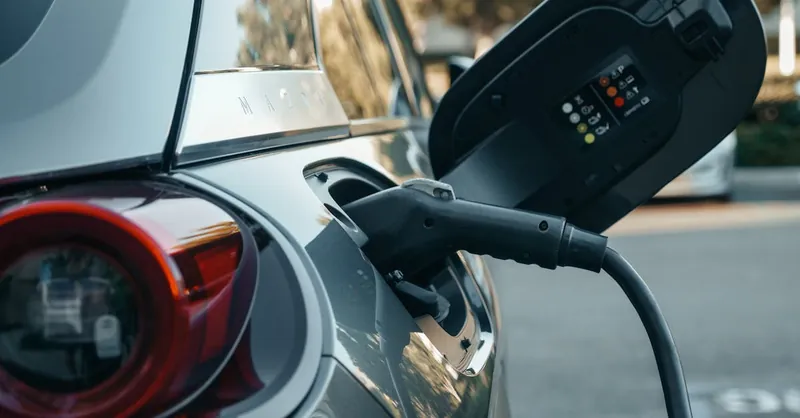
Image courtesy of Kindel Media
